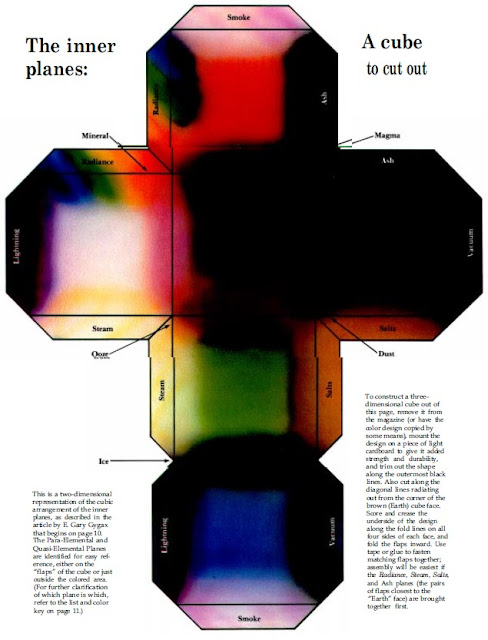His article, "The Inner Planes," which appeared in issue #73 of Dragon (May 1983), demonstrates this maturation process quite clearly, I think. In it, Gygax offers "a new way to look at the AD&D world." This new way was necessary because, as the game's cosmology evolved, there was a need to reconcile new conceptions to earlier presentations. The para-elemental planes, for example, arose out of wondering about what happens at the point where two elemental planes met. Gygax obviously liked the idea, but soon realized that the thought process that led to them was incomplete. After all, there were other Inner Planes, like the Positive and Negative Material Planes, the Ethereal Plane, and the Plane of Shadow (the latter itself a recent addition to the cosmology). How did they interact with the Elemental Planes and what was the effect of all this interaction?
The result is a cubic representation of the Inner Planes, as depicted in this cut-out included on page 13 of this issue:
"What a mess!" you might reasonably say and it is a mess – an ugly, convoluted, and probably unnecessary one at that, but I love it all the same. There are a couple of things I like about this, starting with the fact that it's clearly an attempt by Gygax to think about AD&D's cosmology in rational way. If para-elemental planes arise due to the meeting of two elemental planes, what happens when an elemental plane meets the Positive or Negative Material Plane? What about a para-elemental plane? The result is baroque, almost to the point of absurdity, but it makes sense. One might argue that this is little different than debating how many angels can dance on the head of a pin and I'm somewhat sympathetic to that point of view. At the same time, given what Gygax had already established about the game's metaphysics and the interactions of those metaphysical forces, this oddly colored cube is a natural, even inevitable, evolution of it all.



Jim Hodges ---
ReplyDeleteI love this concept. Good try on Gygax's part.
I completely agree. Things like this won't fit all campaigns, true, but the convoluted feel of planar material from Gygax reminds me of similar convoluted esoteric or antique natural theories in the real world.
ReplyDeleteI love the idea but if I’m reading it correctly, don’t you fold the (labeled) sides inside the cube and glue the model together thereby? I don’t see how the labels actually remain visible after that.
ReplyDeleteAren't each of the elemental planes supposed to be infinite? If so, how do they 'meet'?
ReplyDeleteThe Heretic
In the same way that the Outer Planes do - by conceptual space, not Euclidean space. To illustrate this in realspace, take two squares and cut a slot on one side halfway up and slot them together. That line where they meet is a one dimensional shadow of a two dimensional plane.
DeleteI dunno, maybe it’s my Catholic upbringing, but I always ignored the planes of existence and stuck with traditional cosmologies: either a heaven-hell type thing, or a pagan Asgard/Olympus/What-have-you set-up.
ReplyDeleteI can't blame my wife's Catholic upbringing. I am just too dumb to be able to follow all the extra-planar stuff. Drow cities were about as faraway exotic as we could grip.
DeleteThis what-if extrapolation from half-developed original ideas is what Dragon was great for, and something that we've lost with the demise of periodical publishing. It was a fertile ground of experimentation, and boy did it give us a lot of stuff to argue about amongst friends.
ReplyDeleteI love the whole 1e Manual of the Planes cosmology with para and quasi elements, the plane of Shadow, etc... I tack on later editions like a plane of dreams, Temporal Prime, a Plane of Mirrors, the Demiplane of Dread, Faeries (a.k.a. the Feywild), Jammerspace and the Phlogiston. And, of course, Sigil. There's room in my multiverse (or Omniverse) for them all! We've had SO MUCH FUN with all of these!!!
ReplyDelete